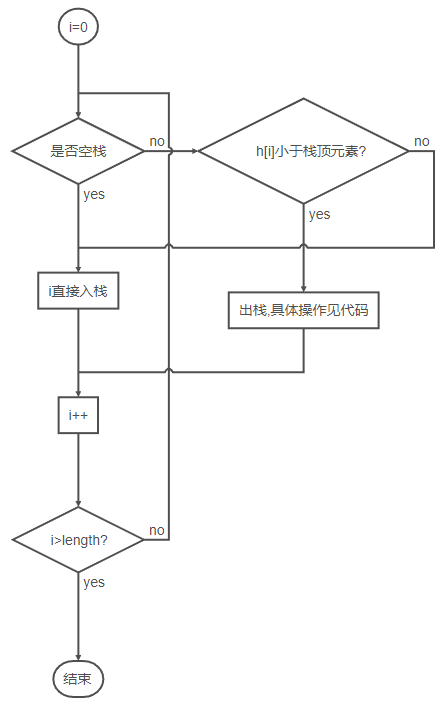Poj 2559 Largest Rectangle in a Histogram


起初这题想了半天,然后瞄到一眼leetcode边上相关话题是"栈"....于是就想到用栈了.(尴尬) 这题若是从两个方向上分别来一次循环也是可以的(单调性),用了栈可以将两次循环合并(相当于剪枝). 用栈起初是没问题,但是我遇到了如 2,1,2 的情况时我就卡主了(当时我没有想到把出栈的数据改值重新入栈).然后参考了下网上其他人的思路才发现还能再压回去.
流程图 (从CSDN转来的流程图代码,掘金没有流程图生成功能...附上图片):
flowchat
st=>start: i=0
e=>end: 结束
putIn=>operation: i直接入栈
putOut=>operation: 出栈,具体操作见代码
iPlus=>operation: i++
ifEmpty=>condition: 是否空栈
ifSmaller=>condition: h[i]小于栈顶元素?
iEnd=>condition: i>length?
st->ifEmpty
ifEmpty(yes)->putIn
ifEmpty(no)->ifSmaller
putIn->iPlus
ifSmaller(yes)->putOut
ifSmaller(no)->putIn
putOut->iPlus
iPlus->iEnd
iEnd(yes)->e
iEnd(no)->ifEmpty

JAVA代码 (LeetCode版本)
/**
* 遍历数组
* 1.栈为空则入栈
* 2.若h[i]>=栈顶元素,入栈
* 3.若h[i]<栈顶元素,则开始出栈计算面积,并将最后出栈的h[x]值改为h[i]再重新入栈
*
* @param heights 数组,本例会创建个新数组,在数组最后一个位置补个高度为0的图
* @return 最大面积值
*/
public int largestRectangleArea(int[] heights) {
int max = 0;
Stack<Integer> s = new Stack<>();
int[] h = new int[heights.length + 1];
for (int i = 0; i < h.length; i++) {
h[i] = i == heights.length ? 0 : heights[i];
if (s.empty()) {
//空栈直接入栈
s.push(i);
continue;
}
if (h[i] < h[s.peek()]) {
//遇到小于栈顶的值,开始出栈,查找最大面积
int top = 0;
while (!s.empty() && h[s.peek()] > h[i]) {
top = s.pop();
max = Math.max((i - top) * h[top], max);
}
//将最后出栈的高度改为h[i]重新入栈
h[top] = h[i];
s.push(top);
s.push(i);
} else {
s.push(i);
}
}
return max;
}
Poj & hdu 版本 ps: poj&hdu的数据量要大一点,得使用long.
import java.util.Scanner;
import java.util.Stack;
public class Main {
/**
* 遍历数组
* 1.栈为空则入栈
* 2.若h[i]>=栈顶元素,入栈
* 3.若h[i]<栈顶元素,则开始出栈计算面积,并将最后出栈的h[x]值改为h[i]再重新入栈
*
* @param heights 数组,本例会创建个新数组,在数组最后一个位置补个高度为0的图
* @return 最大面积值
*/
public long largestRectangleArea(int[] heights) {
long max = 0;
Stack<Integer> s = new Stack<Integer>();
int[] h = new int[heights.length + 1];
for (int i = 0; i < h.length; i++) {
h[i] = i == heights.length ? 0 : heights[i];
if (s.empty()) {
//空栈直接入栈
s.push(i);
continue;
}
if (h[i] < h[s.peek()]) {
//遇到小于栈顶的值,开始出栈,查找最大面积
int top = 0;
while (!s.empty() && h[s.peek()] > h[i]) {
top = s.pop();
max = Math.max((i - top) * (long)h[top], max);
}
//将最后出栈的高度改为h[i]重新入栈
h[top] = h[i];
s.push(top);
s.push(i);
} else {
s.push(i);
}
}
return max;
}
public static void main(String[] args) {
Main n84 = new Main();
// System.out.println(n84.largestRectangleArea(new int[]{1,2,3,2,1,5,6,2,3,2,2}));
// oj summit version
Scanner scan = new Scanner(System.in);
int n;
while ((n = scan.nextInt()) != 0) {
int[] array = new int[n];
for (int i = 0; i < n; i++) {
array[i] = scan.nextInt();
}
System.out.println(n84.largestRectangleArea(array));
}
}
}